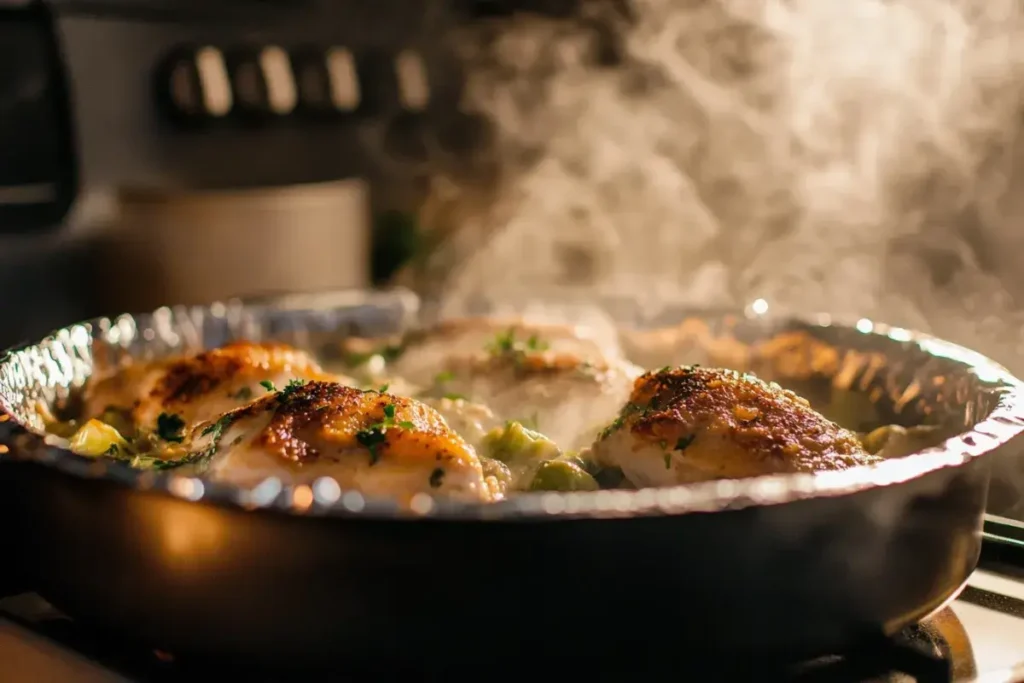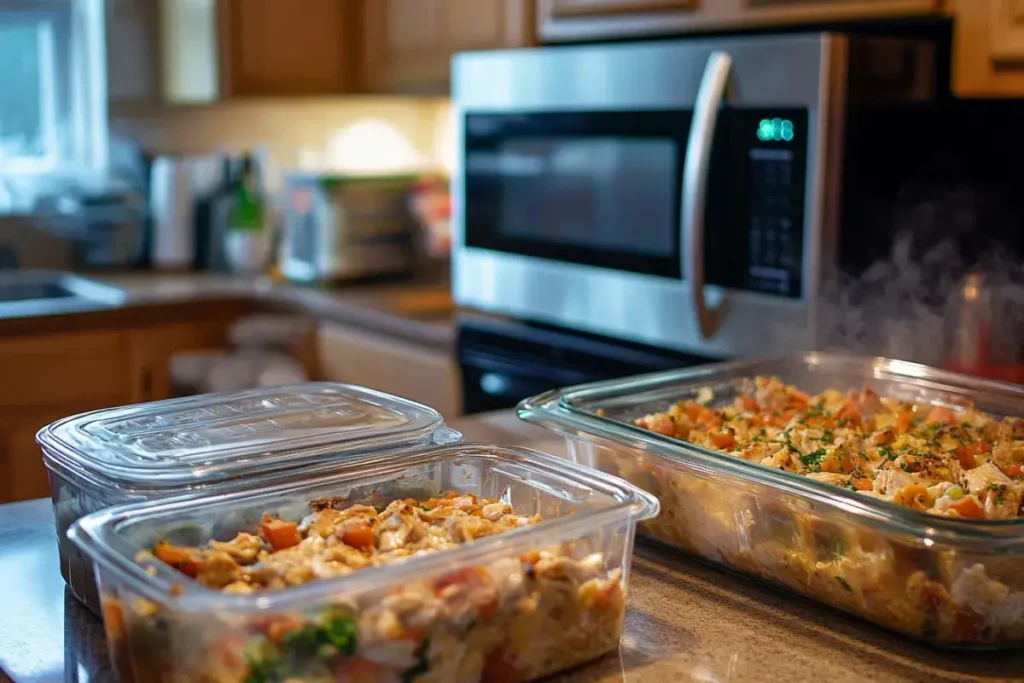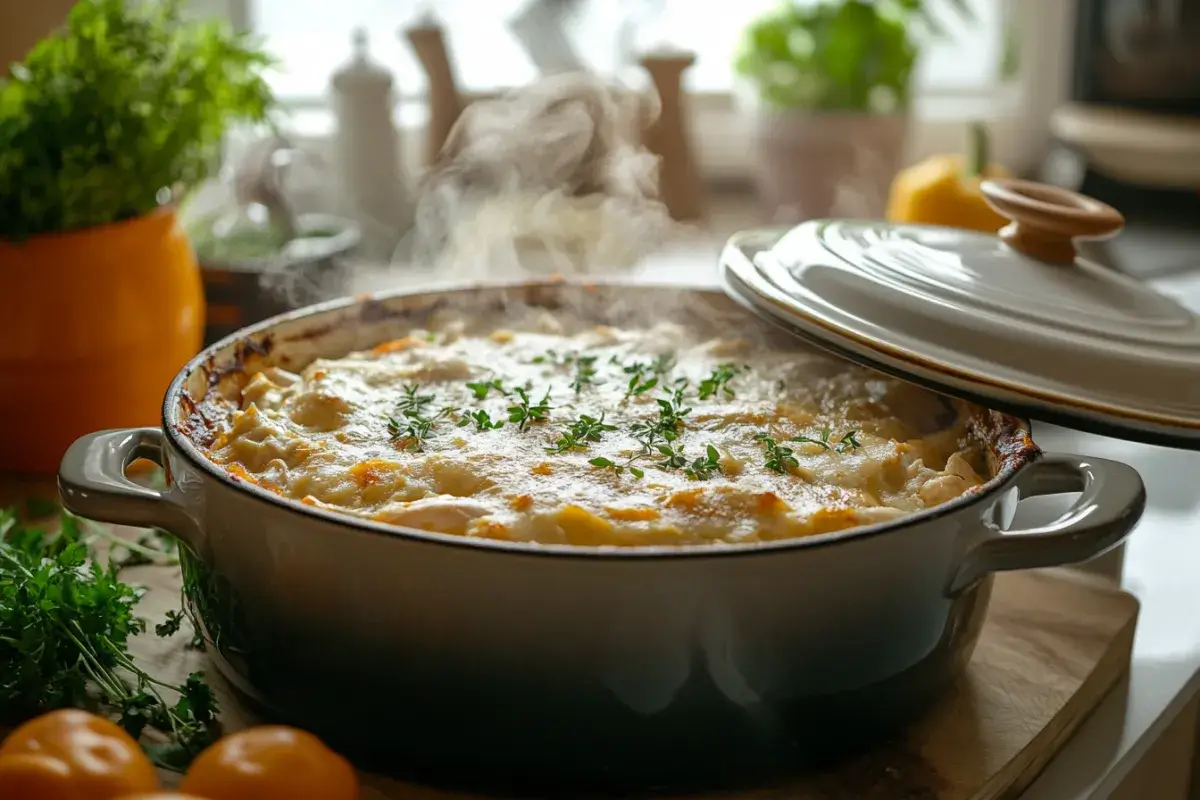1. Introduction
Chicken casseroles are a staple comfort food in many households. With endless variations and simple preparation methods, it’s no surprise they remain a go-to meal, especially on busy weeknights. However, when it comes to baking a chicken casserole, one important question often arises: Should chicken casserole be covered when baking?
This seemingly simple question can dramatically affect the outcome of your dish. The decision to cover or leave the casserole uncovered impacts its texture, moisture level, and overall flavor. In this article, we’ll explore whether you should cover or uncover your casserole and provide helpful tips to ensure your dish comes out just right.
2. What Is a Chicken Casserole?
A chicken casserole is a hearty, baked dish typically made with chicken, vegetables, a starch (like pasta, rice, or potatoes), and often a creamy or tomato-based sauce. These casseroles are beloved for their versatility and convenience, allowing busy cooks to prepare a delicious, all-in-one meal with ease.
There are several popular types of chicken casseroles, including:
- Creamy chicken casseroles: Often made with cream-based soups like cream of chicken or mushroom.
- Mexican-inspired chicken casseroles: Featuring ingredients such as salsa, cheese, and tortillas.
- Vegetable-packed casseroles: With a heavy emphasis on veggies, offering a nutritious boost alongside the chicken.
Since casseroles rely on baking to bring together their many ingredients, understanding how to properly bake them is crucial. Whether you choose to cover your casserole or leave it uncovered can significantly impact the dish’s texture and taste.
For a rich and indulgent take on chicken casseroles, try out this Million Dollar Chicken Casserole recipe.
3. Factors to Consider When Baking a Chicken Casserole
When deciding whether to cover your casserole or not, you’ll need to consider several factors. These elements can greatly influence the final outcome of your dish.
3.1. Moisture Content
One of the most important aspects of a chicken casserole is its moist texture, typically derived from liquid ingredients like broth, sauces, or cream. Covering the casserole helps trap this moisture, ensuring that the chicken and other components remain tender and juicy.
- Tip: If your casserole includes a substantial amount of liquid, covering it while baking will help retain that moisture, preventing the dish from drying out.
3.2. Type of Ingredients
The ingredients play a significant role in answering the key question: Should chicken casserole be covered or left uncovered during baking? For example, casseroles made with raw chicken or uncooked vegetables often benefit from being covered during the baking process. This technique allows the steam to build up, helping those ingredients cook thoroughly.
- Examples: Densely textured vegetables like potatoes, carrots, or broccoli may need extra time to cook through. By covering the dish, you ensure the heat circulates evenly and efficiently throughout the casserole.
If you’re looking for a comforting casserole with simple ingredients, the Easy Chicken Stuffing Casserole is a perfect example
3.3. Oven Temperature and Duration
Most casseroles bake at a moderate temperature, usually between 350°F and 375°F. Covering the dish during the initial stage of baking prevents it from browning too quickly, allowing all the ingredients to cook evenly. However, if you want a crispy topping, you should uncover the casserole during the last 10-15 minutes of baking.
For more detailed tips on managing your oven temperatures, check out this Oven Temperature Guide.
3.4. Desired Texture
The final texture you want to achieve will also dictate whether you should cover the casserole or not. Are you aiming for a soft, steamy dish, or do you prefer a crisp, golden-brown topping?
- Tip: If you prefer a crispy, caramelized top, remove the cover during the last 10-15 minutes of baking. This will allow the surface to brown while the inside remains moist and tender.
4. Should Chicken Casserole Be Covered When Baking?
So, should you cover your chicken casserole or not? The answer depends on the result you’re after. Both options offer distinct advantages.

- Benefits of Covering:
- Retains moisture, ensuring the chicken stays juicy.
- Helps dense vegetables cook more thoroughly.
- Prevents the top from over-browning too quickly.
- Drawbacks of Covering:
- Limits the casserole’s ability to develop a crispy, golden top.
- Can result in a slightly soggy texture if there’s too much liquid inside the dish.
When to cover: It’s best to cover the casserole during the majority of the cooking time, particularly in the beginning stages. This will allow the chicken and vegetables to cook evenly while retaining moisture.
When to uncover: Toward the end of the baking process, usually during the last 10-15 minutes, uncover the casserole to allow the top to crisp up. This way, you achieve a balance between a juicy interior and a crispy topping.
5. Covered vs. Uncovered Chicken Casserole: Side-by-Side Comparison
To help visualize the differences between covering and uncovering your chicken casserole, here’s a helpful comparison:
| Covered Casserole | Uncovered Casserole |
|---|---|
| Retains moisture, creating a juicy texture | Allows for a crispy, golden topping |
| Helps steam vegetables and chicken | Risks drying out ingredients if uncovered for too long |
| Prevents over-browning | Promotes caramelization and browning on top |
In summary, choosing between covering or uncovering your casserole depends on the desired texture. If you’re aiming for a soft and moist dish, covering it is the best option. If you want a crispy, golden crust, be sure to uncover it during the final minutes of baking.
6. Common Mistakes When Baking Chicken Casseroles
Even though casseroles are generally easy to prepare, there are a few common mistakes that can ruin the final product. Avoid these issues to ensure your chicken casserole comes out perfectly every time:
- Overcooking or undercooking the chicken: If your chicken isn’t fully cooked before baking, you’ll need to adjust the bake time accordingly. Be careful not to overcook the other ingredients while waiting for the chicken to finish.
- Adding too much liquid: It’s easy to go overboard with broth or sauces, especially when covering the casserole. Too much liquid will make your dish soggy, so measure carefully.
- Not checking the casserole midway: Always check your casserole about halfway through the baking time. If the top is browning too quickly, consider covering it again or lowering the oven temperature to prevent burning.
By keeping these tips in mind, you can avoid common pitfalls and ensure your chicken casserole turns out delicious every time.
7. Step-by-Step Guide to Baking a Perfect Chicken Casserole
Achieving a perfectly baked chicken casserole requires more than just deciding whether to cover it. The right techniques for preparing and baking can significantly improve your results. Follow this step-by-step guide to ensure your casserole comes out flavorful, juicy, and cooked to perfection.
7.1. Preparing the Ingredients
Before you begin, ensure your ingredients are prepped and ready:
- Chicken: Cut your chicken into bite-sized pieces or use shredded, pre-cooked chicken if you want a quicker bake time.
- Vegetables: Cut any vegetables you plan to include (like carrots, potatoes, or onions) into uniform pieces so they cook evenly.
- Starches: Whether you’re using pasta, rice, or potatoes, ensure they’re either pre-cooked or added in a way that allows them to cook thoroughly within the casserole.
7.2. Layering the Casserole
How you layer your casserole also matters. By organizing your ingredients in a structured way, you ensure even cooking and an ideal blend of flavors.
- Step 1: Start with a base layer of starches (pasta or rice), ensuring they’re spread out evenly.
- Step 2: Add your vegetables next, keeping denser veggies like carrots or potatoes near the bottom.
- Step 3: Add the chicken on top of the veggies. If the chicken is raw, it’s a good idea to place it on top to allow it to cook through more easily.
7.3. Adjusting Liquid Levels
To avoid a dry casserole, ensuring the right amount of liquid is essential. While covering the dish helps retain moisture, you also need to consider how much liquid you’re adding.
- Tip: If your recipe calls for broth, cream, or sauce, make sure there’s enough to create steam when the casserole is covered. However, be cautious not to add too much, as it can lead to sogginess.
- Generally, 1 to 1.5 cups of liquid works well, depending on the size of your dish and the type of ingredients used.
7.4. Baking Time and Temperature
The time and temperature are essential factors when determining whether should chicken casserole be covered or not. Casseroles generally bake at a temperature of 350°F to 375°F, but the exact time will depend on the thickness of your casserole and whether the ingredients are pre-cooked. Here’s a simple guide:
- For casseroles with raw chicken and dense vegetables: Bake covered for about 60-75 minutes at 350°F.
- For casseroles with pre-cooked ingredients: Bake covered for about 30-40 minutes, then uncover for the last 10-15 minutes to brown the top.
7.5. When to Cover and Uncover
As we’ve discussed, the decision to cover or uncover your chicken casserole is crucial for getting the right texture.
- Cover first: Bake the casserole covered for most of the cooking time. This ensures the ingredients, particularly the chicken and vegetables, cook thoroughly and remain moist.
- Uncover later: About 10-15 minutes before the end of baking, remove the cover to allow the top to crisp up, giving your casserole that beautiful, golden finish.
8. Variations of Chicken Casserole Recipes
When deciding should chicken casserole be covered or left uncovered, it’s also important to consider the type of casserole you are making, as different flavors require different techniques. Here are a few delicious variations to try:
- Creamy Chicken Casserole: This variation uses a cream-based sauce (like cream of chicken soup or a homemade béchamel) to create a rich and comforting dish.
- Mexican Chicken Casserole: Add spices like cumin and chili powder, alongside ingredients like corn, beans, and tomatoes, for a zesty twist. Tortilla strips on top give this version a delightful crunch.
- Low-Carb Chicken Casserole: For a lighter option, skip the starches and go heavy on low-carb vegetables like zucchini, cauliflower, and spinach. You can use a cream sauce to add richness without adding carbs.
Looking for ideas to serve with your casserole? Here are some great Side Dishes for Chicken Casserole.
9. How to Prevent a Dry Chicken Casserole
If you’re worried about dryness, a key consideration is should chicken casserole be covered to retain moisture while baking? Dry casseroles are a common problem, but they’re easy to avoid with the right techniques:
- Covering is key: Especially in the early stages, covering your casserole helps trap moisture and keeps the chicken from drying out.
- Monitor liquid levels: If you notice that the casserole looks dry while baking, feel free to add a bit more broth or sauce. You can carefully lift the foil or lid to do this.
- Use juicy ingredients: Ingredients like mushrooms or zucchini release moisture as they cook, naturally adding more liquid to your dish.
By covering and monitoring the liquid content, you’ll ensure that your casserole comes out tender and full of flavor.
10. Tips for Adding a Crispy Topping Without Drying Out the Casserole
One of the best parts of a casserole is its crispy topping, but achieving this without sacrificing moisture can be tricky. Here’s how to balance both:
- Add toppings toward the end: If you’re using breadcrumbs, cheese, or fried onions, wait until the last 10-15 minutes of baking to add them. This ensures they crisp up without overbaking.
- Uncover strategically: As mentioned earlier, uncover the casserole toward the end of the baking process to allow for browning. For those wondering should chicken casserole be covered while adding toppings, uncovering toward the end ensures a crispy top while maintaining a moist filling.
11. How to Store and Reheat Chicken Casseroles
Casseroles are great for meal prep because they store and reheat well. Here’s how to keep your casserole fresh for leftovers:

- Refrigeration: Store leftover casserole in an airtight container in the fridge for up to 3-4 days. Make sure to let the casserole cool before sealing it to avoid excess condensation.
- Freezing: To freeze your casserole, wrap it tightly with plastic wrap and aluminum foil. It can last in the freezer for up to 2-3 months. When reheating, thaw overnight in the fridge for best results.
- Reheating: To maintain moisture, reheat casseroles in the oven at 350°F with the dish covered. Remove the cover during the last 5-10 minutes to restore the crispy top. For detailed instructions, check out this guide on How to Reheat Chicken Casserole to keep your leftovers fresh and delicious.
12. Nutritional Benefits of Chicken Casseroles
Chicken casseroles can offer a healthy and balanced meal when made with the right ingredients:
- Lean protein: Chicken is a great source of lean protein, which is essential for muscle growth and repair.
- Vitamins and minerals: Adding vegetables like spinach, broccoli, or carrots provides valuable nutrients like vitamins A and C, as well as dietary fiber.
- Whole grains: If you use brown rice or whole-grain pasta, your casserole will also deliver complex carbohydrates that provide sustained energy.
When prepared with wholesome ingredients, chicken casseroles are not only delicious but also nutritious.
13. Expert Opinions on Covering Casseroles When Baking
Many chefs and cooking experts agree that covering your chicken casserole for most of the cooking time is the best way to ensure a moist and flavorful dish. Chef insights often recommend uncovering the casserole near the end to achieve that perfect balance between a tender filling and a crispy top.
Additionally, baking experts highlight that when using ingredients like chicken and potatoes, covering them at first helps steam the contents, ensuring even cooking. However, finishing uncovered gives the dish a professional look and flavor by enhancing texture and visual appeal.
14. Conclusion
To sum it up, whether you should cover your chicken casserole while baking depends on your desired outcome. Covering helps retain moisture and ensures the ingredients cook through evenly. However, uncovering toward the end of the baking process is essential if you want a crispy topping and added texture. By understanding when and how to cover your casserole, you’ll achieve the best possible results every time.
15. FAQs
15.1. Can I bake a chicken casserole without covering it at all?
Yes, but baking it uncovered for the entire time can result in a drier dish, especially if your casserole contains minimal liquid. It’s usually best to bake it covered for most of the cooking time, then uncover it to brown the top.
15.2. How do I know when to uncover the casserole?
Uncover the casserole during the last 10-15 minutes of baking, once you notice that the dish has cooked through and the top needs browning.
15.3. What should I use to cover the casserole—foil or a lid?
Both foil and a casserole dish lid work well for covering. If you’re using foil, make sure it’s sealed tightly around the edges to trap steam. If using a lid, ensure it fits snugly on the dish.
15.4. Does covering the casserole affect cooking time?
Yes, covering a casserole can slightly reduce cooking time by trapping heat and moisture, allowing the ingredients to steam. Keep an eye on it, especially if using raw chicken or uncooked vegetables.
15.5. Can I cover the casserole with parchment paper instead of foil?
While parchment paper can be used, it’s less effective than foil or a lid for retaining moisture. If you do use parchment, make sure to double-layer it for better heat retention.

